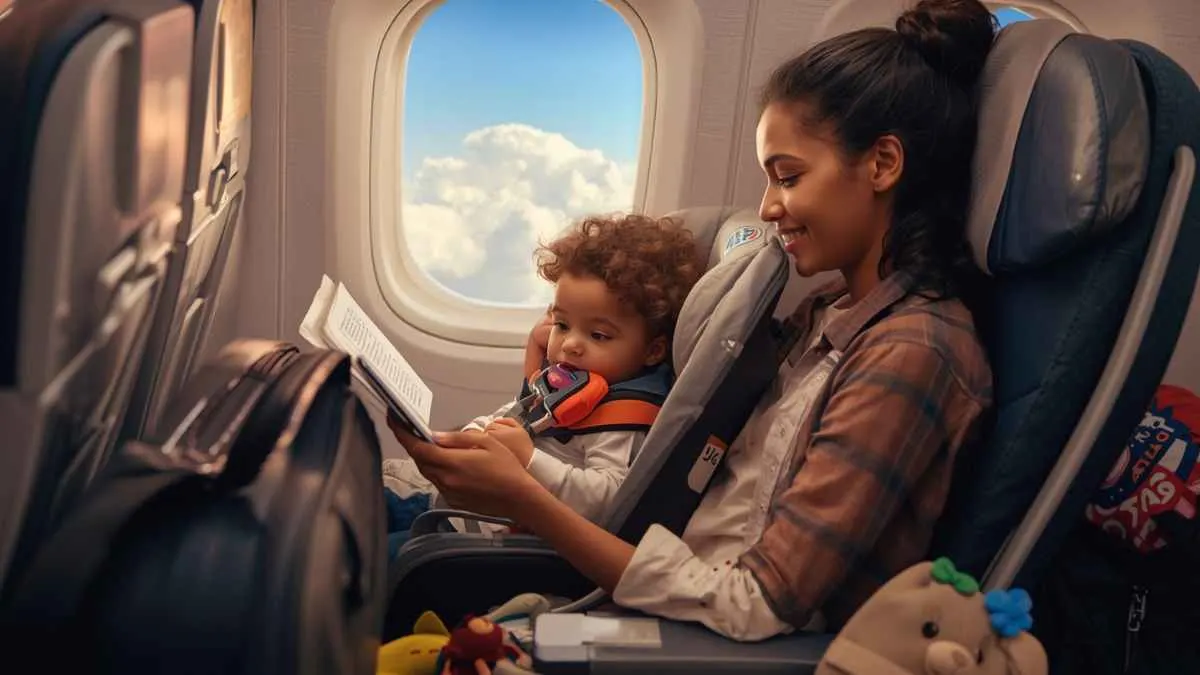Traveling with an infant by plane can be daunting, but with proper preparation, it can be a smooth experience for both parents and babies.
Key tips include booking direct flights, packing the essentials, managing ear pressure during takeoff and landing, and ensuring the baby’s comfort throughout the journey.
Tips for traveling with an infant by plane is a milestone that many new parents are anxious about. The thought of managing a fussy baby in a cramped space for hours, dealing with potential disruptions in sleep schedules, and navigating through airport security can be overwhelming.
However, with a bit of planning and the right strategies, flying with your baby can be a pleasant experience.
Make the journey as smooth and stress-free as possible. We’ll also include references from high-authority sources to back up our advice, ensuring you have trustworthy information to guide your travel plans.
7 Tips For Traveling With An Infant By Plane:

1. Book a Direct Flight
The first tip for traveling with an infant is to book a direct flight whenever possible. Connecting flights can add unnecessary stress to your journey, especially with a baby. Layovers, while they may seem like a chance to stretch your legs, can quickly become frustrating when you are managing all the additional baby-related gear.
Direct flights minimize the time spent in the airport and the number of transitions, making the entire experience less hectic. Also, choosing a flight that aligns with your baby’s naptime or bedtime can encourage them to sleep through the flight, which will be beneficial for both of you.
According to BabyCenter, flights during the baby’s regular sleep schedule help ensure a smoother experience. (babycenter.com)
2. Choose Your Seat Wisely
When booking a flight, consider the seat arrangement that will offer the most comfort and convenience. If your baby is under two years old, most airlines allow you to keep your baby on your lap for the flight. However, this can be uncomfortable for both you and the baby on long flights.
If your budget allows, consider purchasing a separate seat for your baby. Many airlines also offer bassinets for infants on long-haul flights, which are typically available on a first-come, first-served basis.
These bassinets are great for keeping your baby safe and comfortable during naps. Ensure you request one well in advance, as they are in limited supply. (americanbaby.com)
3. Pack Light but Smart
When traveling with an infant, you may feel like you need to pack everything but the kitchen sink. However, packing light is crucial.
While it’s important to bring the essentials, it’s equally important to avoid overpacking, which can make managing your baby on the flight more difficult. Here’s a list of what you should pack in your carry-on:
-
Diapers and wipes
-
Baby formula, breast milk, or snacks (if your baby is old enough)
-
Pacifiers, bottles, and teething toys
-
Blankets, sleep sacks, and extra clothes
-
Toys to keep your baby entertained
-
Hand sanitizers and disinfecting wipes for the tray table
Make sure all liquids (formula, breast milk, baby food) are compliant with TSA regulations. According to the TSA, parents are allowed to bring baby food and formula in reasonable quantities for the flight, but they will need to be screened separately. (tsa.gov)
4. Address Ear Pressure During Takeoff and Landing
One of the most common concerns when flying with an infant is managing ear pressure during takeoff and landing. Babies have smaller eustachian tubes, making it difficult for them to equalize the pressure in their ears, which can cause discomfort and crying.
To minimize this issue, encourage your baby to suck on a pacifier, breastfeed, or bottle-feed during ascent and descent. The sucking action helps to open the eustachian tubes and equalize the pressure. If your baby is older, offering a small snack or drink during these times can also help.
According to pediatricians, keeping your baby engaged in swallowing helps relieve pressure build-up. (healthline.com)
Read Next: 16 Best Road Trip Snacks To Stay Awake | Stay Awake and Energized
5. Stick to a Routine as Much as Possible
Babies thrive on routine, and disruptions to their usual sleep schedule or eating habits can lead to fussiness. When traveling by plane, it’s important to maintain your baby’s regular routine as much as possible. Choose flight times that align with your baby’s typical naptime or bedtime to increase the chances that your baby will sleep during the flight.
You can also bring along familiar comfort items, such as a favorite blanket, stuffed animal, or sleep sack. These items will help soothe your baby and create a sense of security in an unfamiliar environment.
As Dr. Sally S. Smith, pediatrician at Johns Hopkins Children’s Center, suggests, “Bringing along familiar items helps maintain some continuity for the baby during travel.” (hopkinsmedicine.org)
6. Dress Your Baby Comfortably
Airplanes can be notoriously cold, and babies tend to get chilly quickly. Dress your baby in comfortable layers that can be easily added or removed as needed. A onesie or pajamas is often the best option, as it’s easy to move in and comfortable for sleeping.
If your baby tends to get cold easily, pack an extra sweater or jacket for them. For longer flights, a baby blanket or sleeping bag can also help to keep your baby warm and cozy during the flight.
7. Stay Calm and Be Patient
One of the best things you can do for yourself and your baby while flying is to stay calm. Babies can be unpredictable, and sometimes they cry, regardless of how well you prepare. It’s essential to remember that many fellow passengers are parents themselves and understand the challenges that come with traveling with an infant.
Try to remain patient and flexible. If your baby becomes fussy, take a few deep breaths, and remember that the situation is temporary. Flight attendants are often helpful and can assist with things like providing an extra bottle of water or helping with stowing your carry-on luggage.
(FAQs):
Q1: Can I bring formula or breast milk on the plane?
Yes, you can bring breast milk, formula, or baby food on the plane. However, TSA regulations require that these items be presented for separate screening. The amount should be reasonable for the duration of the flight. (tsa.gov)
Q2: Can my baby sit on my lap during the flight?
Yes, most airlines allow infants under two years old to sit on your lap for the flight. However, for long flights, consider purchasing a separate seat for your baby for added comfort.
Q3: How can I help my baby sleep during the flight?
Try to align your flight times with your baby’s regular sleep schedule. Bring familiar items like a blanket or comfort toy to help them feel secure and calm. If possible, book flights during your baby’s typical naptime or bedtime.
Q4: What should I do if my baby gets fussy during the flight?
If your baby gets fussy, stay calm and patient. Offer comfort with a pacifier, bottle, or breastfeeding. Walk with your baby up and down the aisle if needed, or use soothing sounds or gentle rocking to calm them down.
Last Call:
Traveling with an infant by plane doesn’t have to be stressful. By planning ahead, packing wisely, managing ear pressure, and maintaining your baby’s routine as much as possible, you can ensure that the flight is smooth for both you and your baby.
Remember, while things may not go perfectly, staying calm and being prepared will help you manage the challenges that come with air travel.
With these tips, you’re ready to take to the skies with confidence. Safe travels! Stay with Rima Blog.
References:
-
“Traveling with an Infant: Tips for Parents,” BabyCenter. (babycenter.com)
-
“TSA Guidelines for Baby Formula and Breast Milk,” Transportation Security Administration. (tsa.gov)
-
“How to Survive a Long Flight with an Infant,” American Baby Magazine. (americanbaby.com)
-
Dr. Sally S. Smith, Pediatrician at Johns Hopkins Children’s Center. (hopkinsmedicine.org)
-
“Managing Ear Pressure for Babies During Flights,” Healthline. (healthline.com)

